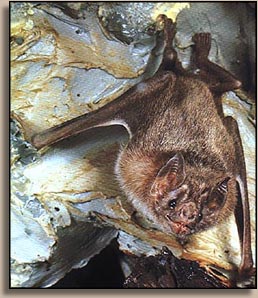

Bats are unmistakable. No mammals other than bats have true wings and flight. Bat wings are modified forelimbs, much as are bird wings, except in the case of bats the flight surface is covered with skin and supported by four fingers, while in birds the flight surface is provided mostly by feathers and is supported by the wrist and two digits. The flight membrane usually extends down the sides of the body and attaches to the hind legs. Bats also often have a membrane called a uropatagium that runs between their hind legs and includes their tail (if they have one).
Bats are the second-most speciose group of mammals, after rodents. The approximately 925 species of living bats make up around 20% of all known living mammal species. In some tropical areas, there are more species of bats than of all other kinds of mammals combined.
Bats are found throughout the world in tropical and temperate habitats. They are missing only from polar regions and from some isolated islands.
There are two major groups of bats, usually given the rank of suborders, Megachiroptera and Microchiroptera The Megachiroptera includes one family (Pteropodidae) and about 166 species. All feed primarily on plant material, either fruit, nectar or pollen. The remaining 16 families (around 759 species) belong to the Microchiroptera. The majority of species are insectivorous, and insectivory is widely distributed through all microchiropteran families. But many microchiropterans have become specialized for other kinds of diets. Some are carnivorous (feeding on rodents, other bats, reptiles, birds, amphibians, even fish), many consume fruit, some are specialized for extracting nectar from flowers, and one group of three species feeds on nothing but the blood of other vertebrates. Megachiropterans and microchiropterans differ in many other ways. The "megabats" are found only in the Old World tropics, while "microbats" are much more broadly distributed. Microbats use highly sophisticated echolocation for orientation; megabats orient primarily using their eyes (members of one genus are capable of a primitive form of echolocation). Megabats control their body temperature with a tight range of temperatures and none hibernates; many microbats have labile body temperatures, and some hibernate. Megabats have claws on the second digits supporting their wings (with one exception); this is never the case in microbats. Megabats have relatively simple external ears; microbats often have large and relatively complex pinnae, including an enlarged tragus or antitragus. Microbats often have dilambdodont dentition or cheek teeth whose morphology can easily be related to dilambdodont teeth; megabats have simplified cheek teeth that are difficult to interpret. A controversy has arisen recently concerning whether the two major groups of bats are monophyletic. While this issue is not settled, at present most evidence seems to favor the hypothesis that they are monophyletic; that is, the most recent common ancestor shared by the two groups would also be classified as a bat.
An important cranial characteristic for recognizing bat families is the nature of the premaxilla.
The earliest fossil bat is a remarkably well preserved animal from early Eocene rocks in the Green River formation of Wyoming. Given the name Icaronycteris, it comes from a species that is clearly microchiropteran. This implies that the split between the two groups occurred substantially earlier, and the fossil sheds no light on the question of whether bats are monophyletic.
Suborder Megachiroptera
Family Pteropodidae (Old World fruit-eating bats)
Suborder Microchiroptera
Family Rhinopomatidae (long-tailed or mouse-tailed bats) Family Craseonycteridae (bumblebee bat) Family Emballonuridae (sac-winged or sheath-tailed bats) Family Nycteridae (slit-faced or hollow-faced bats) Family Megadermatidae (false vampire bats) Family Rhinolophidae (horseshoe bats or Old-World leaf-nosed bats) Family Noctilionidae (bull-dog or mastiff bats) Family Mormoopidae (naked-backed bats) Family Phyllostomidae (New World leaf-nosed bats) Family Natalidae (funnel-eared or long legged bats) Family Furipteridae (smoky or thumbless bats) Family Thyropteridae (disc-winged bats) Family Myzopodidae (old world sucker-footed bats) Family Vespertilionidae (evening bats) Family Mystacinidae (New Zealand short-tailed bats) Family Molossidae (free-tailed bats)
<<<<<<<>>>>>>> ARTIODACTYLA CARNIVORA CETACEA CHIROPTERA DASYUROMORPHIA DERMOPTERA DIDELPHIMORPHI DIPROTODONTIA HYRACOIDEA INSECTIVORA LAGOMORPHA MACROSCELIDEA MICROBIOTHERIA MONOTREMATA NOTORYCTEMORPHIA PAUCITUBERCULATA PERAMELEMORPHIA PERISSODACTYLA PHOLIDOTA PRIMATES PROBOSCIDEA RODENTIA SCANDENTIA SIRENIA TUBULIDENTATA XENARTHRA
Email: eradani7@aol.com